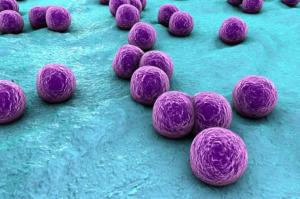Bacterial intruder seeks a warm welcome
Posted on January 16, 2016 by Helen Cope, University of Edinburgh
Among hospital-acquired bacterial infections, Staphylococcus aureus is one of the most prevalent. Cunningly, this bacterium can evade the body’s natural defences by hiding within the host’s own cells. It seems, however, that S.aureus prefers some cells to others since it is found at varying levels in different bodily tissues. The reason for this variation has recently been investigated by researchers from the University of Sheffield – who hoped to understand more about how S.aureus latches onto and invades host cells and ultimately how this behaviour might be blocked.

This research was published in the December 2012 issue of the Journal of Medical Microbiology.
Integrins, transmembrane proteins, are distributed randomly across the surface of mammalian cells. They act as receptors facilitating the interaction between the cell and the environment that surrounds it, such as another cell. S.aureus effectively exploits this system by attaching itself to type α5β1 integrins. This causes cellular changes that create a way for the bacteria to invade the cell. The Sheffield-based researchers investigated S.aureusinvasion of three different cell types. They showed that despite having the same levels of integrin α5β1, cells taken from the skin and the oral cavity were invaded to a much greater extent than those from the nasal cavity. This was all the more surprising since the nasal cavity is considered a primary site of S.aureus colonisation whereas the oral cavity is not regarded as a colonisation site. Further investigation revealed, however, that the binding-capability (activity) of nasal cell integrin α5β1 was significantly lower than the activity of integrin on the other two cell types. This demonstrated for the first time that the binding-capability of integrin α5β1 is just as important as its quantity in determining the extent of bacterial invasion.
Setting the results in context, the authors pointed out that other factors must be considered. Firstly, in order for S.aureus to bind to integrin α5β1 it must first gain access to the cell surface. Within the body, this is affected by the presence of saliva, mucus, or other bacterial species – factors that were not present in the study. Secondly, there is growing evidence that S.aureus is able to use other routes besides integrin α5β1 to enter cells. The involvement of extra receptor molecules on the cell surface that aid bacterial invasion could explain the variation in cell invasion levels observed in the study.
S.aureus can cause minor to life-threatening infections in a wide variety of tissue types. If the invasion of host cells by S.aureus could be blocked, it would be rendered more vulnerable to the action of the immune system or to antibiotics. Developing methods to block cell invasion requires understanding of the routes by which S.aureus enters cells. This study was the first to show that invasion of mammalian cells by S.aureus depends on both expression level and activity of integrin α5β1.
